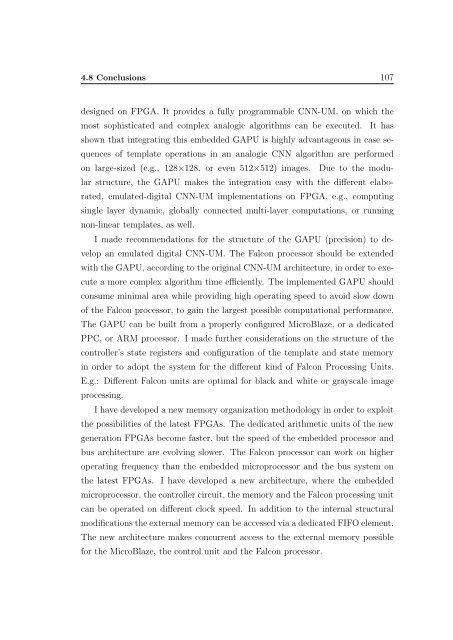PPKE ITK PhD and MPhil Thesis Classes
PPKE ITK PhD and MPhil Thesis Classes
PPKE ITK PhD and MPhil Thesis Classes
Create successful ePaper yourself
Turn your PDF publications into a flip-book with our unique Google optimized e-Paper software.
4.8 Conclusions 107<br />
designed on FPGA. It provides a fully programmable CNN-UM, on which the<br />
most sophisticated <strong>and</strong> complex analogic algorithms can be executed. It has<br />
shown that integrating this embedded GAPU is highly advantageous in case sequences<br />
of template operations in an analogic CNN algorithm are performed<br />
on large-sized (e.g., 128×128, or even 512×512) images. Due to the modular<br />
structure, the GAPU makes the integration easy with the different elaborated,<br />
emulated-digital CNN-UM implementations on FPGA, e.g., computing<br />
single layer dynamic, globally connected multi-layer computations, or running<br />
non-linear templates, as well.<br />
I made recommendations for the structure of the GAPU (precision) to develop<br />
an emulated digital CNN-UM. The Falcon processor should be extended<br />
with the GAPU, according to the original CNN-UM architecture, in order to execute<br />
a more complex algorithm time efficiently. The implemented GAPU should<br />
consume minimal area while providing high operating speed to avoid slow down<br />
of the Falcon processor, to gain the largest possible computational performance.<br />
The GAPU can be built from a properly configured MicroBlaze, or a dedicated<br />
PPC, or ARM processor. I made further considerations on the structure of the<br />
controller’s state registers <strong>and</strong> configuration of the template <strong>and</strong> state memory<br />
in order to adopt the system for the different kind of Falcon Processing Units.<br />
E.g.: Different Falcon units are optimal for black <strong>and</strong> white or grayscale image<br />
processing.<br />
I have developed a new memory organization methodology in order to exploit<br />
the possibilities of the latest FPGAs. The dedicated arithmetic units of the new<br />
generation FPGAs become faster, but the speed of the embedded processor <strong>and</strong><br />
bus architecture are evolving slower. The Falcon processor can work on higher<br />
operating frequency than the embedded microprocessor <strong>and</strong> the bus system on<br />
the latest FPGAs. I have developed a new architecture, where the embedded<br />
microprocessor, the controller circuit, the memory <strong>and</strong> the Falcon processing unit<br />
can be operated on different clock speed. In addition to the internal structural<br />
modifications the external memory can be accessed via a dedicated FIFO element.<br />
The new architecture makes concurrent access to the external memory possible<br />
for the MicroBlaze, the control unit <strong>and</strong> the Falcon processor.






![optika tervezés [Kompatibilitási mód] - Ez itt...](https://img.yumpu.com/45881475/1/190x146/optika-tervezacs-kompatibilitasi-mad-ez-itt.jpg?quality=85)









